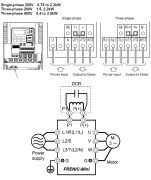I made a mistake. I live in a Canadian residence with 120V 60Hz single phase power, that has 240V to run the dryer and oven. I bought a used 240V air compressor, ran ok, but did not make enough compressed air fast enough.
I ordered a bigger air compressor from China, built to my (incorrect) specifications. I wanted a 7.5hp motor (5.5kw) that was 240V, 60Hz, and they said that is 3 phase only; but I could use a 11kw VFD to convert my single phase 240 to 3 phase, and they would build it in. I agreed. I was told when they tested it the compressor was drawing 38 amps at 240V, so 9120kw. However, when the compressor arrived, the 240 input is Live, Neutral, Ground. My residential 240V is Live Live ground. Live and learn.
I had an electrician look at it, and he told me I need to buy either a 240V to 240V transformer or an RPC (wired straight to the motor). I have spent the last couple of weeks contacting transformer companies and asking for a quote on a 240V to 240V 15kva transformer, but they seem to be very uncommon. I might have a line on one, I'll know the asking price later this week. I also could buy a 25hp RPC and try to wire that in instead. If I do that, and attach the RPC to the motor input, does that mean the VFD will run in reverse, converting the supplied 3 phase power to single phase? Or will that burn it out and I need to bypass the VFD completely?
Assuming the prices of the RPC and transformer are similar, which is a better choice? Or is there another option I am not aware of?
Extra info that may or may not be important:
1. the new compressor is an oil free scroll type, not a piston type like the old one, so it is supposedly a lot quieter, and can start up slower, using less of a spike power draw.
2. One transformer company offered to build me a 15kva 120V to 240V transformer, but my electrician said that would be a 76amp draw from the panel, and not allowed, so I need to stick to 240V inputs for whichever I choose.
I ordered a bigger air compressor from China, built to my (incorrect) specifications. I wanted a 7.5hp motor (5.5kw) that was 240V, 60Hz, and they said that is 3 phase only; but I could use a 11kw VFD to convert my single phase 240 to 3 phase, and they would build it in. I agreed. I was told when they tested it the compressor was drawing 38 amps at 240V, so 9120kw. However, when the compressor arrived, the 240 input is Live, Neutral, Ground. My residential 240V is Live Live ground. Live and learn.
I had an electrician look at it, and he told me I need to buy either a 240V to 240V transformer or an RPC (wired straight to the motor). I have spent the last couple of weeks contacting transformer companies and asking for a quote on a 240V to 240V 15kva transformer, but they seem to be very uncommon. I might have a line on one, I'll know the asking price later this week. I also could buy a 25hp RPC and try to wire that in instead. If I do that, and attach the RPC to the motor input, does that mean the VFD will run in reverse, converting the supplied 3 phase power to single phase? Or will that burn it out and I need to bypass the VFD completely?
Assuming the prices of the RPC and transformer are similar, which is a better choice? Or is there another option I am not aware of?
Extra info that may or may not be important:
1. the new compressor is an oil free scroll type, not a piston type like the old one, so it is supposedly a lot quieter, and can start up slower, using less of a spike power draw.
2. One transformer company offered to build me a 15kva 120V to 240V transformer, but my electrician said that would be a 76amp draw from the panel, and not allowed, so I need to stick to 240V inputs for whichever I choose.





